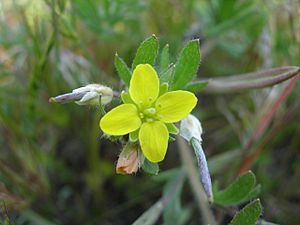Dobie pod facts for kids
Quick facts for kids Dobie pod |
|
|---|---|
 |
|
| Scientific classification | |
| Genus: |
Tropidocarpum
|
| Species: |
gracile
|
Tropidocarpum gracile is a small flowering plant. It is also known as the dobie pod. This plant belongs to the Brassicaceae family, which includes many well-known plants like mustard and cabbage. It grows naturally in California and Baja California.
Where Dobie Pods Grow
Dobie pods are very adaptable. They can be found in many different places. These include coastal canyons, inland mountains, and even deserts. You might see them in areas with chaparral (dense shrubs) or scrublands. They also grow in woodlands, on beaches, in valleys, and near dry riverbeds called washes. This shows how tough and versatile this plant is!
Plant Appearance
The dobie pod is an annual herb. This means it completes its whole life cycle in one year. Its stems can grow from 10 to 50 centimeters long. They often spread out and have many branches. The stems are covered in tiny, rough hairs.
Leaves and Flowers
The leaves near the bottom of the plant are quite long. They can be 10 to 15 centimeters in length. These leaves have wavy, finger-like edges. Leaves higher up on the stem are shorter. They might also have fewer divisions.
The flowers grow in a cluster called a raceme. This is a common way for flowers in the mustard family to grow. Each flower has four petals. These petals are about 4 millimeters long. They are usually yellow. Sometimes, they can have a purple tint.
Fruits and Seeds
After the flowers bloom, the plant produces a fruit. This fruit is a long, narrow seed pod. It is called a silique. These pods can be several centimeters long. Inside, they hold many tiny brown seeds.

